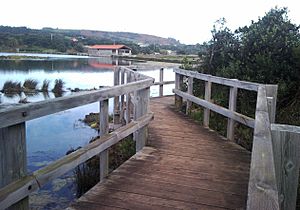Santa Olaja mill facts for kids
Quick facts for kids Santa Olaja mill |
|
|---|---|
| Native name Spanish: Molino de Santa Olaja |
|

Soana Marshes with the Santo Olaja tide mill in the background
|
|
| Location | Arnuero, Cantabria, Spain |
| Area | 300 square metres (3,200 sq ft) |
| Official name: Molino de Santa Olaja | |
| Type | Non-movable |
| Criteria | Monument |
| Designated | 1988 |
| Reference no. | A.R.I. 51 - 0005373 - 00000 |
| Lua error in Module:Location_map at line 420: attempt to index field 'wikibase' (a nil value). | |
The Santa Olaja mill is a special old building located in the Joyel Marshes. You can find it in a place called Soano, which is part of the town of Arnuero in Cantabria, Spain. This amazing mill was officially recognized as a Cultural Heritage Site in November 2013, meaning it's a very important historical place.
Contents
Discover the Santa Olaja Mill
The Santa Olaja mill is a unique type of mill called a tide mill. It's one of the main attractions in the Trasmiera Ecopark. This park was even chosen as an EDEN destination winner in 2011!
How Does a Tide Mill Work?
Tide mills are special because they use the power of the ocean's tides to grind grain. Imagine a giant natural pool that fills up with water when the tide is high. The mill has dams that hold this water in. When the tide goes out, the stored water is released. This flowing water then turns big wheels inside the mill, which powers the grinding machines. It's a clever way to use nature's energy!
The Mill's Design and History
The Santa Olaja mill was built a very long time ago, in the 14th century. It kept working until 1953. This mill was very important because it had ten large wheels! That shows how much work it could do. We don't know the exact year it was first built, but it was rebuilt in 1695.
The mill is about 300 square meters in size. It's made of two buildings connected by a wall. The mill is built with strong stone blocks, especially at the corners. On the side facing the sea, it has six rounded arches. The other side has strong supports called buttresses.
Exploring the Mill Today
The building was fixed up in 2002. Now, it's a museum where you can learn all about how tide mills worked. You can see the different jobs people did there and how important these mills were to the local economy long ago. The Santa Olaja mill helps us understand the traditional way of life in this region.
Inside the mill, there are two main parts. You enter through a porch that leads to a room. In this room, you can see the machinery of one mill wheel and parts of three others that have been put back together. There are also tools used for grinding grain and several grinding stones with special grooves. The room next to it has a floor that is partly made of glass, so you can see below!
See also
 In Spanish: Molino de Santa Olaja para niños
In Spanish: Molino de Santa Olaja para niños

